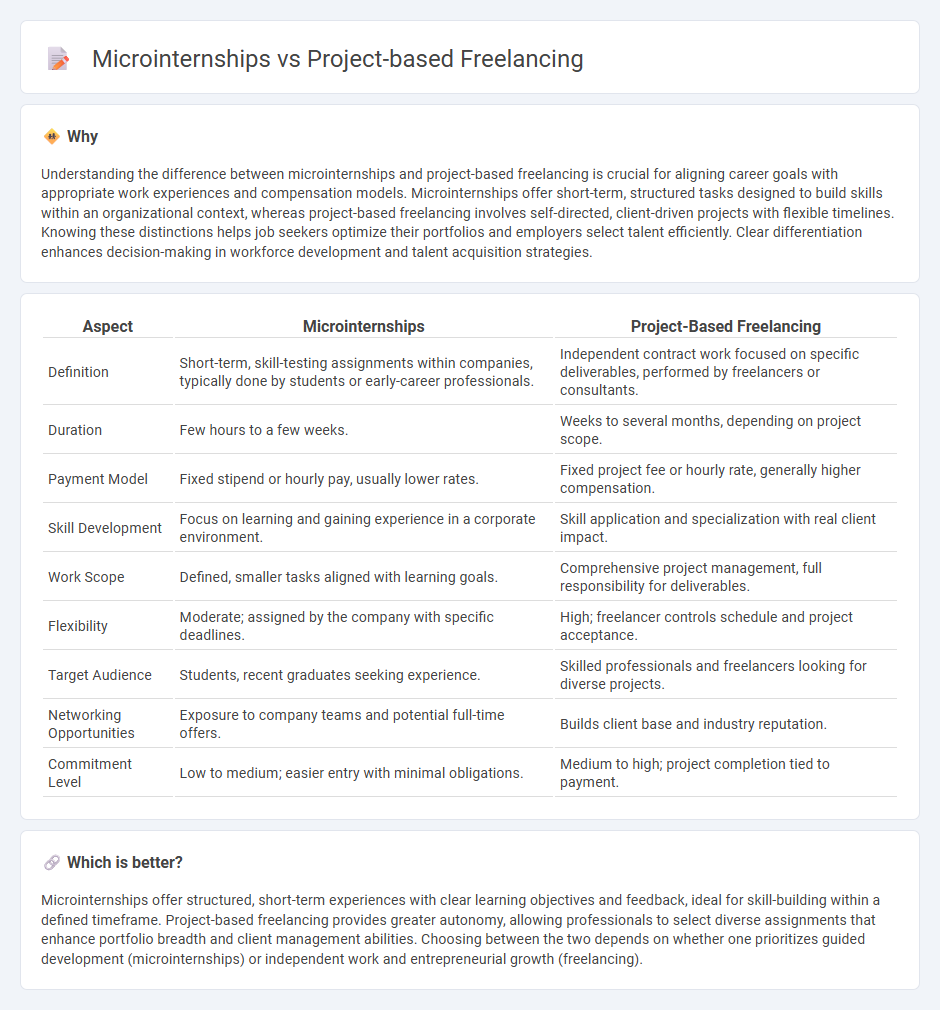
Microinternships offer short-term, skill-specific tasks typically lasting a few days to weeks, providing students and early-career professionals with hands-on experience while earning income. Project-based freelancing involves managing entire projects from start to finish, allowing independent contractors to leverage specialized expertise and build a diverse portfolio on platforms like Upwork or Fiverr. Explore the nuances between these models to decide which aligns best with your career goals.
Why it is important
Understanding the difference between microinternships and project-based freelancing is crucial for aligning career goals with appropriate work experiences and compensation models. Microinternships offer short-term, structured tasks designed to build skills within an organizational context, whereas project-based freelancing involves self-directed, client-driven projects with flexible timelines. Knowing these distinctions helps job seekers optimize their portfolios and employers select talent efficiently. Clear differentiation enhances decision-making in workforce development and talent acquisition strategies.
Comparison Table
| Aspect | Microinternships | Project-Based Freelancing |
|---|---|---|
| Definition | Short-term, skill-testing assignments within companies, typically done by students or early-career professionals. | Independent contract work focused on specific deliverables, performed by freelancers or consultants. |
| Duration | Few hours to a few weeks. | Weeks to several months, depending on project scope. |
| Payment Model | Fixed stipend or hourly pay, usually lower rates. | Fixed project fee or hourly rate, generally higher compensation. |
| Skill Development | Focus on learning and gaining experience in a corporate environment. | Skill application and specialization with real client impact. |
| Work Scope | Defined, smaller tasks aligned with learning goals. | Comprehensive project management, full responsibility for deliverables. |
| Flexibility | Moderate; assigned by the company with specific deadlines. | High; freelancer controls schedule and project acceptance. |
| Target Audience | Students, recent graduates seeking experience. | Skilled professionals and freelancers looking for diverse projects. |
| Networking Opportunities | Exposure to company teams and potential full-time offers. | Builds client base and industry reputation. |
| Commitment Level | Low to medium; easier entry with minimal obligations. | Medium to high; project completion tied to payment. |
Which is better?
Microinternships offer structured, short-term experiences with clear learning objectives and feedback, ideal for skill-building within a defined timeframe. Project-based freelancing provides greater autonomy, allowing professionals to select diverse assignments that enhance portfolio breadth and client management abilities. Choosing between the two depends on whether one prioritizes guided development (microinternships) or independent work and entrepreneurial growth (freelancing).
Connection
Microinternships and project-based freelancing both offer flexible, short-term work opportunities that allow individuals to build skills and gain experience without long-term commitments. These models connect by leveraging digital platforms that match talent with businesses needing specific projects completed efficiently. The rise of remote work technologies has accelerated the integration of microinternships and freelancing, fostering a gig economy that emphasizes adaptability and continuous learning.
Key Terms
Contract Scope
Project-based freelancing typically involves clearly defined contract scopes with detailed deliverables and timelines, ensuring both parties understand responsibilities and expectations. Microinternships offer shorter-term, flexible engagements that often focus on specific tasks or projects without extensive contractual obligations, making them ideal for quick skill development and portfolio building. Explore the nuances between these approaches to determine which contract scope best aligns with your career goals and project needs.
Duration
Project-based freelancing typically involves engagements that span several weeks to months, allowing for in-depth completion of complex tasks and deliverables. Microinternships are short-term, often lasting from a few hours to a few days, providing quick, focused experiences that fit into tight schedules. Explore our comprehensive guide to understand which option aligns best with your career goals and time availability.
Compensation Structure
Project-based freelancing typically involves negotiated payments based on deliverables, often resulting in lump-sum or milestone-based compensation that reflects the project's scope and complexity. Microinternships offer fixed, smaller-scale payments for short-term tasks designed to provide real-world experience, often with standardized rates depending on task duration and skill requirements. Explore more to understand which compensation structure aligns best with your career goals and financial expectations.
Source and External Links
The Pros and Cons of Project-Based Employment - TechBridge Inc. - Project-based freelancing involves hiring skilled professionals for specific, short-term projects with clear deliverables, allowing businesses to manage specialized needs without long-term commitments.
Freelancers, Here's How to Thrive in a Project-Based World - Thriving in project-based freelancing requires proactive work-seeking, personal branding, financial management, and continuous skill development to navigate the growing gig economy.
Upwork | Hire Top Freelance Talent with Confidence - Platforms like Upwork connect businesses with freelance professionals for project-based work, offering tools for job posting, talent screening, and milestone-based payments.
 dowidth.com
dowidth.com